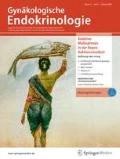Zusammenfassung
Der vorliegende Beitrag erläutert die Vor- und Nachteile des einzigen in Europa verfügbaren subdermalen kontrazeptiven Implantats – Implanon®. Die kontrazeptive Effizienz ist bei korrekter Anwendung hoch. Das Nebenwirkungsprofil ist insgesamt als günstig einzustufen. Eine entsprechende Beratung bei eventuell auftretenden Blutungsstörungen inklusive möglicher Therapieoptionen sowie die möglichst oberflächliche Insertion sind allerdings zu beachten.
Abstract
This report describes the advantages and disadvantages of Implanon®, the only subdermal contraceptive device available in Europe. Contraceptive efficacy is high with correct insertion. Overall, the side effect profile is acceptable. Clinical aspects concerning counseling and insertion as well as possible bleeding disturbances and potential therapeutic options are discussed.



Literatur
Affandi B, Korver T, Geurts TB, Coelingh Bennink HJ (1999) A pilot efficacy study with a single-rod contraceptive implant (Implanon) in 200 Indonesian women treated for ≤ 4 years. Contraception 59:167–174
Ahrendt HJ, Egarter C (2011) Blutungsstörungen unter reiner Gestagen-Langzeitkontrazeption mit subdermalen Implantaten. Frauenarzt 52:2–7
Ahrendt HJ, Egarter C (2011) Management von Zusatzblutungen unter subdermalen Implantaten. Frauenarzt 52:493–501
Beerthuizen R, Beek A van, Massai R et al (2000) Bone mineral density during long-term use of the progestogen contraceptive implant Implanon compared to a non-hormonal method of contraception. Hum Reprod 15:118–122
Biswas A, Viegas OA, Roy AC (2003) Effect of Implanon and Norplant subdermal contraceptive implants on serum lipids – a randomized comparative study. Contraception 68:189–193
Biswas A, Biswas S, Viegas OA (2004) Effect of etonogestrel subdermal contraceptive implant (Implanon) on liver function tests – a randomized comparative study with Norplant implants. Contraception 70:379–382
Bitzer J, Tschudin S, Alder J (2004) Acceptability and side-effects of Implanon in Switzerland: a retrospective study by the Implanon Swiss Study Group. Eur J Contracept Reprod Health Care 9:278–284
Blumenthal PD, Voedisch A, Gemzell-Danielsson K (2011) Strategies to prevent unintended pregnancy: increasing use of longacting reversible contraception. Hum Reprod Update 17:121–137
Croxatto HB, Makarainen L (1998) The pharmacodynamics and efficacy of Implanon. An overview of the data. Contraception 58:91S–97S
Croxatto HB, Urbancsek J, Massai R et al (1999) A multicentre efficacy and safety study of the single contraceptive implant Implanon. Implanon Study Group. Hum Reprod 14:976–981
Croxatto HB (2000) Clinical profile of Implanon: a single-rod etonogestrel contraceptive implant. Eur J Contracept Reprod Health Care 5:21–28
Davies GC, Feng LX, Newton JR et al (1993) Release characteristics, ovarian activity and menstrual bleeding pattern with a single contraceptive implant releasing 3-ketodesogestrel. Contraception 47:251–261
Edwards JE, Moore A (1999) Implanon. A review of clinical studies. Br J Fam Plann 24:3–16
Egberg N, Beek A van, Gunnervik C et al (1998) Effects on the hemostatic system and liver function in relation to Implanon and Norplant. A prospective randomized clinical trial. Contraception 58:93–98
Flores JB, Balderas ML, Bonilla MC et al (2005) Clinical experience and acceptability of the etonogestrel subdermal contraceptive implant. Int J Gynaecol Obstet 90:228–233
Funk S, Miller MM, Mishell DR Jr et al (2005) Safety and efficacy of Implanon, a single-rod implantable contraceptive containing etonogestrel. Contraception 71:319–326
Harrison-Woolrych M, Hill R (2005) Unintended pregnancies with the etonogestrel implant (Implanon): a case series from postmarketing experience in Australia. Contraception 71:306–308
Hidalgo MM, Lisondo C, Juliato CT et al (2006) Ovarian cysts in users of Implanon and Jadelle subdermal contraceptive implants. Contraception 73:532–536
Hohmann H, Creinin MD (2007) The contraceptive implant. Clin Obstet Gynecol 50:907–917
Implanon Package Insert (2006) Organon USA Inc. Roseland
Lakha F, Glasier AF (2006) Continuation rates of Implanon in the UK: data from an observational study in a clinical setting. Contraception 74:287–289
Lidegaard Ø, Nielsen LH, Skovlund CW, Løkkegaard E (2012) Venous thrombosis in users of non-oral hormonal contraception: follow-up study, Denmark 2001–10. BMJ 344:e2990
Makarainen L, Beek A van, Tuomivaara L et al (1998) Ovarian function during the use of a single contraceptive implant: implanon compared with Norplant. Fertil Steril 69:714–721
Mansour D, Korver T, Marintcheva-Petrova M, Fraser IS (2008) The effects of Implanon on menstrual bleeding patterns. Eur J Contracept Reprod Health Care 13:13–28
Mansour D, Fraser IS, Walling M et al (2008) Methods of accurate localisation of non-palpable subdermal contraceptive implants. J Fam Plann Reprod Health Care 34:9–12
Mansour D (2009) UK provision for removal of non-palpable contraceptive implants. J Fam Plann Reprod Health Care 35:3–4
Mansour D, Mommers E, Teede H et al (2010) Clinician satisfaction and insertion characteristics of a new applicator to insert radiopaque Implanon: an open-label, noncontrolled, multicenter trial. Contraception 82:243–249
Meckstroth KR, Darney PD (2001) Implant contraception. Semin Reprod Med 19:339–354
Meirik O, Farley TM, Sivin I (2001) Safety and efficacy of levonorgestrel implant, intrauterine device, and sterilization. Obstet Gynecol 97:539–547
Palomba S, Falbo A, Di Cello A et al (2012) Nexplanon: the new implant for long-term contraception. A comprehensive descriptive review. Gynecol Endocrinol 28:710–721
Reinprayoon D, Taneepanichskul S, Bunyavejchevin S et al (2000) Effects of the etonogestrelreleasing contraceptive implant (Implanon on parameters of breastfeeding compared to those of an intrauterine device). Contraception 62:239–246
Shulman LP, Gabriel H (2006) Management and localization strategies for the nonpalpable Implanon rod. Contraception 73:325–330
Taneepanichskul S, Reinprayoon D, Thaithumyanon P et al (2006) Effects of the etonogestrelreleasing implant Implanon and a nonmedicated intrauterine device on the growth of breast-fed infants. Contraception 73:368–371
Weisberg E, Hickey M, Palmer D et al (2006) A pilot study to assess the effect of three short-term treatments on frequent and/or prolonged bleeding compared to placebo in women using Implanon. Hum Reprod 21:295–302
Weisberg E, Hickey M, Palmer D et al (2009) A randomized controlled trial of treatment options for troublesome uterine bleeding in Implanon users. Hum Reprod 24:1852–1861
Wenzl R, Beek A van, Schnabel P et al (1998) Pharmacokinetics of etonogestrel released from the contraceptive implant Implanon. Contraception 58:283–288
Einhaltung der ethischen Richtlinien
Interessenkonflikt. C. Egarter erhielt von MSD und Bayer/Schering Honorare für Studien, Vorträge sowie Expertentreffen auf dem Gebiet der Kontrazeption. Dieser Beitrag beinhaltet keine Studien an Menschen und Tieren.
Author information
Authors and Affiliations
Corresponding author
Rights and permissions
About this article
Cite this article
Egarter, C. Subdermale kontrazeptive Implantate. Gynäkologische Endokrinologie 11, 175–183 (2013). https://doi.org/10.1007/s10304-012-0536-0
Published:
Issue Date:
DOI: https://doi.org/10.1007/s10304-012-0536-0

